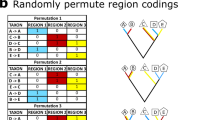Abstract
IN 1991 Graur et al. raised the question of whether the guinea-pig, Cavia porcellus, is a rodent1. They suggested that the guinea-pig and myomorph rodents diverged before the separation between myomorph rodents and a lineage leading to primates and artiodactyls. Several findings have since been reported, both for and against this phylogeny, thereby highlighting the issue of the validity of molecular analysis in mammalian phylogeny. Here we present findings based on the sequence of the complete mitochondrial genome of the guinea-pig, which strongly contradict rodent monophyly. The conclusions are based on the cumulative evidence provided by orthologically inherited genes and the use of three different analytical methods, none of which joins the guinea-pig with myomorph rodents. In addition to the phylogenetic conclusions, we also draw attention to several factors that are important for the validity of phylogenetic analysis based on molecular data.
This is a preview of subscription content, access via your institution
Access options
Subscribe to this journal
Receive 51 print issues and online access
$199.00 per year
only $3.90 per issue
Buy this article
- Purchase on Springer Link
- Instant access to full article PDF
Prices may be subject to local taxes which are calculated during checkout
Similar content being viewed by others
References
Graur, D., Hide, W. A. & Li, W. H. Nature 351, 649–652 (1991).
Li, W. H., Hide, W. A., Zharkikh, A., Ma, D. P. & Graur, D. J. Heredity 83, 174–181 (1992).
Graur, D., Hide, W. A., Zharkirkh, A. & Li, W. H. Comp. Biochem. Physiol. 101B, 495–498 (1992).
Wolf, B., Reinecke, K., Aumann, K. D., Brigelius-Flohè, R. & Flohè, L. Biol. Chem. Hoppe-Seyler 374, 641–649 (1993).
Noguchi, T., Fujiwara, S., Hayashi, S. & Sakuraba, H. Comp. Biochem. Physiol. 107, 179–182 (1994).
Ma, D. P., Zharkikh, A., Graur, D., VandeBerg, J. L. & Li, W. H. J. molec. Evol. 36, 327–334 (1993).
Hasegawa, M., Cao, Y., Adachi, J. & Yano, T. Nature 355, 595 (1992).
Cao, Y., Adachi, J., Yano, T. & Hasegawa, M. Molec. Biol. Evol. 11, 593–604 (1994).
Kuma, K. & Miyata, T. Jap. J. Genet. 69, 555–566 (1994).
Frye, M. S. & Hedges, S. B. Molec. Biol. Evol. 12(1), 168–176 (1995).
Martignetti, J. A. & Brosius, J. Proc. natn. Acad. Sci. U.S.A. 90, 9698–9702 (1993).
Novacek, N. J. Nature 356, 121–125 (1992).
Graur, D. FEBS Lett. 325, 152–159 (1993).
Graur, D., Duret, L. & Gouy, M. Nature 379, 333–335 (1996).
Swofford, D. L. PAUP: Phylogenetic Analysis Using Parsimony Version 3.1.1 (Illinois Natural History Survey, Champaign, 1993).
Adachi, J. & Hasegawa, M. MOLPHY: Programs for Molecular Phylogenetics 2.2 (Computer Science Monographs, No. 27, Institute of Statistical Mathematics, Tokyo, 1992).
Saccone, C., Lanave, C., Pesole, G. & Preparata, G. Meth. Enzym. 183, 570–583 (1990).
Irwin, D. M., Kocher, T. D. & Wilson, A. C. J. molec. Evol. 32, 128–144 (1991).
Arnason, U., Gullberg, A. & Widegren, B. J. molec. Evol. 33, 556–568 (1991).
Graur, D. & Higgins, D. G. Molec. Biol. Evol. 11, 357–364 (1994).
Krettek, A., Gullberg, A. & Arnason, U. J. molec. Evol. 41, 952–957 (1995).
Saitou, N. & Nei, M. Molec. Biol. Evol. 4, 406–425 (1987).
Arnason, U., Xu, X. & Gullberg, A. J. molec. Evol. 42, 145–152 (1996).
Arnason, U. & Johnsson, E. J. molec. Evol. 34, 493–505 (1992).
Arnason, U., Gullberg, A., Johnsson, E. & Ledje, C. J. molec. Evol. 37, 323–330 (1993).
Xu, X. & Arnason, U. Gene 148, 357–362 (1994).
Devereux, J., Haeberli, P. & Smithies, O. Nucleic Acids Res. 12, 387–395 (1984).
Felsestein, J. PHYLIP (Phytogeny Inference Package), Version 3.5c (University of Washington, Seattle, 1993).
Author information
Authors and Affiliations
Rights and permissions
About this article
Cite this article
D'Erchia, A., Gissi, C., Pesole, G. et al. The guinea-pig is not a rodent. Nature 381, 597–600 (1996). https://doi.org/10.1038/381597a0
Received:
Accepted:
Issue Date:
DOI: https://doi.org/10.1038/381597a0
This article is cited by
-
Independent acquisition of sulfide tolerance in a population of tubificine worms: a habitat extension for the Limnodrilus hoffmeisteri complex
Organisms Diversity & Evolution (2023)
-
Phylogeny and chronology of the major lineages of New World hystricognath rodents: insights on the biogeography of the Eocene/Oligocene arrival of mammals in South America
BMC Research Notes (2013)
-
Complete mitochondrial genome of the Eurasian flying squirrel Pteromys volans (Sciuromorpha, Sciuridae) and revision of rodent phylogeny
Molecular Biology Reports (2013)
-
Transient knockdown and overexpression reveal a developmental role for the zebrafish enosf1b gene
Cell & Bioscience (2011)
-
Automated Removal of Noisy Data in Phylogenomic Analyses
Journal of Molecular Evolution (2010)
Comments
By submitting a comment you agree to abide by our Terms and Community Guidelines. If you find something abusive or that does not comply with our terms or guidelines please flag it as inappropriate.



